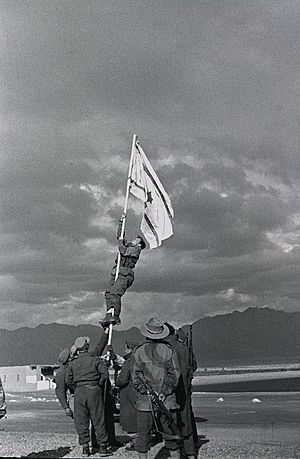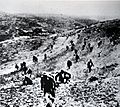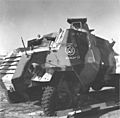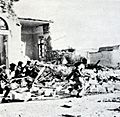1948 Palestine War facts for kids
Quick facts for kids 1948 Palestine War |
|||||||
|---|---|---|---|---|---|---|---|
| Part of Arab-Israeli Conflict | |||||||
 Raising the Ink Flag at Umm Rashrash (Eilat) |
|||||||
|
|||||||
| Belligerents | |||||||
| Israel |
Palestine |
||||||
| Commanders and leaders | |||||||
| David Ben-Gurion | Hajj Amin al-Husayni | ||||||
| Strength | |||||||
| 35,000 in May 1948, 96,441 by the end of the war | |||||||
The 1948 Palestine War, also known as the War of Independence to Israelis (people from Israel), was a war between the new state of Israel, east Israelian Arabs, and the other states around Israel. The war began in 1947 after the announcement of the end of the British Mandate in Palestine (the British control of the region) and the separation of the land into two countries of the same size. By the end of the war in 1949 Israel had expanded (made bigger) its land beyond its given borders. The Arab state created in the UN Partition Plan (UN Separation Plan) never came into existence as its two largest parts of land, the Gaza Strip (small piece of land south of Palestine on the coast) and the West Bank (region east of Jerusalem and west of the Jordan River), went into the control of Egypt and Jordan one by one. The war continues to be an issue in the Middle East today. For Israelis, it shows the change from the Yishuv (the Jewish group in Palestine) to the state of Israel (even though the War of Independence took place). Other countries had to deal with the idea of loss and the difficulties of local arguments caused by the creation of a special Jewish State in a highly Arab region. Palestinians remember the war as The Nakba (lit. Catastrophe, Arabic: النكبة, al-Nakba), the war that broke up a growing nation and pushed its people away.
Background
Jewish settlement
Beginning in 1881, European Jews began to move to Palestine in large numbers. These new immigrants mainly settled in the region under the banner of Jewish nationalism, known as Zionism. The goal of this nationalist movement was the creation of a Jewish state. Although at first friendly, relations between Arabs in Palestine and Jews from Europe became more bitter as the number of Jews moving grew.
Palestinian Nationalism and the Great Revolt
During World War One, Arabs and Jews were under the rule of the Ottoman Empire. To weaken the Empire, her enemies (Britain and France), began to offer land to peoples in sections of the Empire for launching resistance to the Ottomans. This included offering Palestine to various Arab leaders (including the Husayn family of Saudi Arabia). At the same time, the British offered control of Palestine to a Jewish state that didn't yet exist. Although this action led to nothing, it still encouraged greater movement of Jews to Palestine as well as a fear of losing regional control for the Palestinians. In 1936, responding to the growing Jewish population, Palestinian Arabs led an armed revolt against the British and Jews in Palestine. The revolt, led by the mufti and head of the Arab Higher Committee Hajj Amin al-Husayni, was the first large-scale expression of a sense of Palestinian nationalism. Though it ended with the British and Jews putting down the revolt, the resulting White Paper of 1939 proved it had been an influential piece of resistance. Under the 1939 White Paper, Jews could only send a further 75,000 immigrants over 5 years and the goal of giving over Israel to Palestine. This situation, two cultures competing against each other for Palestine, continued to be the case throughout World War Two. At the end of that conflict, the British Mandate in Palestine was near ending and the peoples of the region wanted a solution to the issue.
UN Resolution
In 1947, the British gave the issue of competing peoples within Palestine to the United Nations. The United Nations Special Committee on Palestine was tasked with fizing the issue of violence between the two groups and treating each side with fairness in the giving-out of land. On November 29, 1947, the Partition Plan was announced. Palestine would be divided into separate Jewish and Arab states of roughly equal size. Jerusalem would remain an independent city run by the UN. Finally, the British would leave the Mandate of Palestine by May 1948. At first, most of the international community supported the plan (including both the US and USSR) as well as the Yishuv. Palestinian Arabs, as well as the nations of Egypt, Lebanon, Syria, Iraq, Saudi Arabia, and Transjordan (now Jordan) argued against the plan and pushed for a new one with an Arab state and a recognized Jewish minority. When that was not accepted, these nations moved for war by raising armies to fight the new state of Israel.
Armed forces
Jewish Community (Israel after May 15, 1948)
Given its recent status as a state, the Yishuv actually had one of the most well-organized and well-armed military forces in the region. This force fell under the control of the Haganah, a single state army and the army that would become the modern Israeli Defense Force (IDF)(the switch was made in late May 1948). By mid-May, the state of Israel had called up an army of 35,000. As the war continued into July, that number trended up to 65,000. At the end of the war, Israel had successfully brought up and armed 96,441 men to fight against the Palestinians and Arab nations. Additionally, Israel was unique for having a developed strategic plan and a simple command system. Under the leadership of David Ben-Gurion, the minister of defense, the state of Israel could count on a force with unified leadership and a plan.
Palestinian Forces
Unlike the Yishuv, the Palestinians had no unified force before the war began in late 1947. There were several paramilitary groups, but no single leader, structure or plan. Al-Husayni and the Arab Higher Committee tried to give the fighters a system. Yet, many disliked his leadership and did not think of the committee as the voice of Palestinians. Still, al-Husayni successfully created a rag-tag force known as the Holy War Army made up of new volunteers and paramilitary forces. This army and the other Palestinian fighters, however, lacked modern weapons and supplies. Though al-Husayni pushed the Arab League (a collection of majority Arab nations) for greater support and control to direct the course of the war, the League blocked him.
Arab League Forces
The nations of the Arab League that joined in the war against Israel were Egypt, Transjordan, Iraq, Lebanon, and Syria (there was a smaller force from Saudi Arabia and Yemen under Egyptian command). Despite having the League to bind them, at the start of the war there was no single League commander. Each country mobilized its own force for its own goals. The force was thus not one League force but a collection of forces. The final force from the Arab League, the Arab Liberation Army, was a force of 4,000 volunteers from across the Middle East which worked out of Syria. While the nations of the Arab League surrounded Israel, they did so as different countries.
Objectives
Yishuv/Israel
Israel's objectives for the war were originally based on the Haganah's 1946 Plan and run by David Ben-Gurion. The plan called for the rapid build-up of forces to fight against what the army saw as the greatest threat: invasion from the many Arab states. By using the 1946 Plan, Ben-Gurion hoped to secure the land given to Israel in the UN Partition Plan. As the war went on, the goals changed slightly with the introduction in March 1948 of Plan Dalet (Plan D). Instead of simply holding the lands given to Israel, the plan now commanded Israel's forces to work remove Arabs from Jewish-controlled land, defend Jewish settlements in Arab Palestine, and to take Arab land at particular positions for a strategic advantage. A possible reason for the change is given by historian David Tal, who points out that it was probably a response to the stiffer resistance from Palestinians and a general desire to put Israeli forces in the most defensible positions. Yet, as Tal also points out, this strategic plan has never been without some controversy, particularly the part of the plan which forced Palestinian movement.
Palestine
The principal objective for the Palestinians, as expressed by the Arab Higher Committee, was the creation of a single Arab state in Palestine.
Transjordan/Jordan
While Transjordan outwardly agreed with the rest of the Arab League in creating an Arab state in Palestine, that seems to have not been Transjordan's ultimate goal. According to the records of Transjordan, King Abdullah, Transjordan's Hashemite (royal family) monarch, was interested in using the war as an excuse to put Palestinian Arabs under Jordanian control. This would then put him into a position to seize Syria and create a Greater Syria. This means that Transjordan's objectives were seemingly in opposition to those Syria, Lebanon, Egypt, and the Palestinians themselves.
Syria and Egypt
Like Transjordan, both Syria and Egypt supported creating a single Arab state in Palestine. Their reasoning, however, was more about stopping the spread of Jordanan, who both nations feared (should Transjordan take the region).
Course of the War
Phase 1: The Civil War
The first part of the conflict pitted the Yishuv's forces against those of the Palestinian's Arab Higher Committee. The civil war began with three days of strikes on November 30, 1947. It then changed into a guerrilla campaign against Jewish supply trucks. In January 1948, the Arab Liberation Army entered Palestine. This stiff resistance caused the Israelis to adapt their plan and to introduce Plan Dalet. On April 5th, the Haganah launched Operation Nahshon, a fifteen-day operation to secure routes to Jerusalem by seizing hills along the main roads. After the success of Operation Nahshon and smaller Jewish offensives, Palestinian resistance began to fall apart.
Phase 2: The Arab League countries invade
The second part of the war began with the invasion of Egypt, Iraq, Transjordan, Lebanon, and Syria in May 1948. Each invasion force basically entered Palestine on the nearest border. Fighting in the West Bank and around Jerusalem dominated this phase of the war. Jewish forces moved into Jerusalem to secure the western section of the city. To shore up this position, Israeli forces also tried to take Latrun, a hill to the north of Jerusalem. This proved unsuccessful. In other areas, the Israelis found greater success. Two Egyptian forces, one moving along the coast and the other across the Negev towards Jerusalem, were both halted. The Iraqi force was pushed back. Though Syrian and Lebanese forces made an advance into Israeli territories, Israelis made counter advances into Syrian and Lebanese territory. Fighting was brought to an end by a UN truce on June 11.
Phase 3: Israeli Push Against Transjordans
On July 9th, the Israelis launched a new series of operations against the Jordanians in the West Bank. The hope was to end the conflict in this front against what Israelis considered to be the most well-trained and armed Arab army, Transjordan's Arab Legion. The offensives were largely a success and although other Arab nations tried to take advantage of Israel's focus on the West Bank, their advances were small. This phase of the war ended with another truce on July 18, 1948.
Phase 4: Israeli push against Egypt, Syria, and Lebanon
With the Jordanians stuck in the West Bank, Israelis launched two more offensives on October 15th. These forced Egyptian forces out of the Negev Desert and pushed back Syrian and Lebanese forces into their own countries. Following these last offensives, the military part of the war ended. Still, it would take until January 7, 1949 for Israel to complete signing treaties with each warring nation.
Results
Through the war, Israel gained a large amount of land. While the original separation lines gave about equal land to Jewish and Arab states, the treaty lines of 1949 gave Israel a much larger state, limiting Arab-controlled land to the small Gaza strip and a smaller West Bank (than in 1947. Yet, these were not controlled by any Palestinian government. Instead, Egypt controlled the small Gaza Strip while Jordan controlled the West Bank and Eastern Jerusalem. An additional aspect to the aftermath of the war was the Palestinian refugee crisis. By the end of the war, there were approximately 720,000 refugees living in camps in Syria, Jordan, Lebanon, the West Bank, and the Gaza Strip. Although much of this can be attributed to war-time fear, some historians, like James Gelvin, assert that Israeli policy in Plan Dalet partially contributed to this crisis. The policy, which encouraged Israeli forces to seize Arab property in Jewish territory, exacerbated the refugee issue. As of 2015, the right of these refugees to return to their former homes or to receive reparations remains uncertain.
Images for kids















